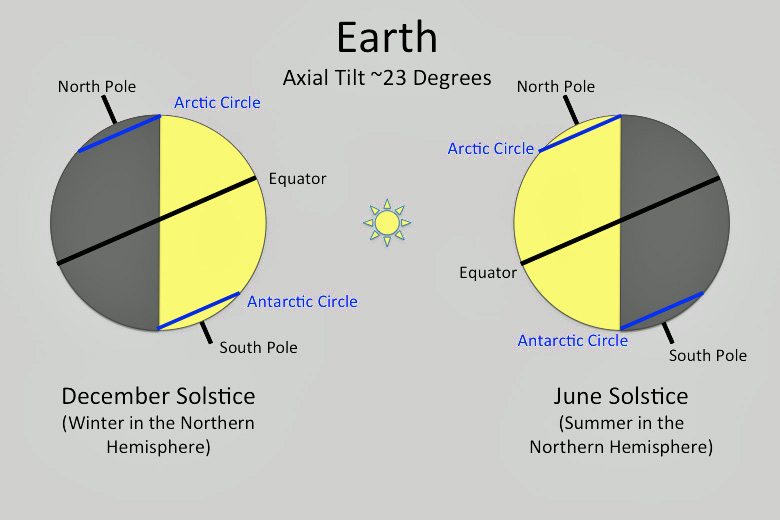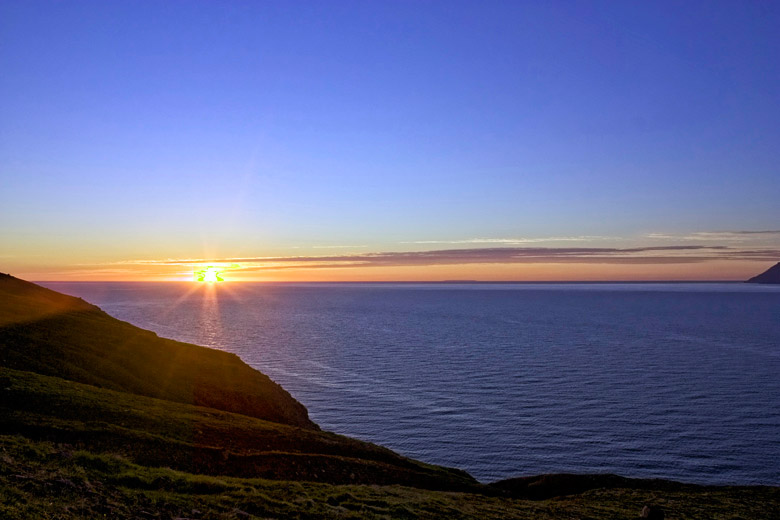Daylight hours: sunrise & sunset
Daylight hours represent the amount of time from sunrise to sunset - not to be confused with sunshine hours, which shows how much bright sunshine you can expect at your chosen destination in every month of the year.
Understanding how daylight hours are measured, plus where, when and why places see more or less daylight throughout the year, is helpful to anyone planning a holiday, especially if you're after some winter sun - no one wants to discover too late that they're chosen somewhere shrouded in darkness!
- How the tilt of the earth affects daylight
- Daylight hours throughout the seasons
- Daylight hours around the world
- Sunrise and sunset times

How the tilt of the earth affects daylight hours
Due to its spherical nature, at any moment in time half the earth is illuminated by the sun while the other half is in darkness.
This does not mean that everywhere half the time is spent in daylight and the other half in darkness: the distribution of daylight and darkness is complicated by the fact that the earth is tilted on its axis by around 23.5° relative to its orbit around the sun.
At the height of the European summer, when the northern hemisphere is tilted towards the sun, it experiences more daylight hours than the southern hemisphere which at the same time will be tilted away from the sun.
Exactly six months later the tables are reversed when the southern hemisphere is tilted towards the sun with more daylight hours in the southern hemisphere.
The sun rises earlier and sets later in summer in both hemispheres the further north or south you go because the circles of latitude nearer the poles are exposed to direct sunlight for a longer proportion of the day when the pole in question is facing more towards the sun.
Notice how in summer the sun rises in the north east and sets in the north west, and only in March and September does it rise exactly in the east and set exactly in the west. Notice also how much higher in the sky the sun appears in summer than in winter - approximately 47° higher - which is double the angle of the tilt.
The earth does not wobble on its axis over the period of a year. The north and south poles point constantly in the same direction all year round.
Daylight hours throughout the seasons
As the earth reaches the two points that are equidistant between seasons there comes a time - the two equinoxes: one in March and the other in September - when all places on earth experience 12 hours of daylight and 12 hours of darkness.
All circles of latitude are exposed to direct sunlight for the same proportion (exactly half) of the day on that day.
Did you know? Over a 12 month period all places on earth receive the same total number of daylight hours.
Within the Arctic and Antarctic circles, the 23.5° tilt is sufficient that within these areas some places are bathed in daylight continuously at the height of summer, the opposite also being true that they receive no daylight at all during winter.
For example, from the last two weeks of May to the third week of July the sun does not set in Tromso, northern Norway. While in winter, the sun is not visible from the last few days of November until the middle of January.

At the poles the situation is more extreme, in that they have only one sunrise and one sunset during the whole year separated by six months of continuous daylight followed by six months of darkness.
Daylight hours around the world
At the equator the tilt of the earth's axis has minimal effect on daylight hours. In Singapore, which is less than 100 miles north of the equator, the number of daylight hours varies by only 10 minutes throughout the year.
At high latitudes however, such as at Inverness in northern Scotland, the difference is more like 12 hours between midwinter and midsummer.
The benefit of long days in summer always being matched by long periods of darkness in winter: 18 hours of daylight in midsummer; only six and a half hours in midwinter.
While the 23.5° tilt is pretty much fixed, the earth's orbit around the sun is not a perfect circle - it is slightly elliptical. The orbit varies by about three million miles, the earth being closest to the sun in the first week of January and furthest away in the first week of July.
It is worth remembering that even when daylight hours are limited (i.e. in winter) just travelling a little way towards the equator will give you more daylight hours.
A top tip for anyone seeking winter sun: if you travel south from the UK in winter you are not only likely to experience warmer weather but longer days as well.
On Christmas Day, while London receives nearly an hour's more daylight than Edinburgh with just under eight hours, Benidorm sees around and nine and half hours, and Maspalomas in Gran Canaria enjoys nearly 10.5 hours.
Daylight hours: sunrise and sunset times
With longer days in summer the sun naturally rises earlier and sets later, and vice versa in winter.
As the earth is roughly symmetrical in shape the longer period of daylight is split also roughly between a) more daylight at the beginning of the day, matched by b) more daylight at the end of the day.
However the two are not matched exactly because of: a) the axial tilt of the earth, and especially b) its eccentric orbit around the sun.
The eccentric orbit means that the length of day as measured from solar noon on one day to solar noon on the next varies slightly throughout the year. From January to the end of March days are somewhat longer when measured this way (of course only by a tiny amount).
In the middle of February it takes about 15 minutes longer from one solar noon to the next when compared with the time at the winter solstice.
This is not because the rotation of the earth has slowed - this is always constant - it is because both the earth and the sun are moving relative to each other.
Did you know? The sun sets faster at the equator than at higher latitudes - this is because the speed of rotation of the earth is faster at the equator - approximately 25,000 miles in 24 hours at the equator compared with 11,000 miles in 24 hours at the Arctic circle.
Later in the year, around the end of October, days are 16 minutes shorter when compared with the clock. By the time the earth has completed one orbit the shorter and longer times will cancel each other out, so the overall effect is neutral over 365.25 days.
The effect is known as the 'equation of time' and was first recognised as early as 1500BC by the Babylonians.

An example of the effect can be seen in sunrise and sunset times around the summer and winter solstice - approximately 21st June and 21st December. Even though the day of the summer solstice has the greatest number of daylight hours it is not the day that the sun rises earliest and sets latest.
The earliest sunrise of the year in the UK occurs about a week before the summer solstice, and the latest sunset about a week after the solstice.
In winter the effect is more exaggerated - the earliest sunset occurs about 10 days before the solstice and the latest sunrise about 10 days after the solstice. This is the time of year when the earth is closest to the sun.
If delving into daylight hours makes you hungry for more about the weather and climate in destinations around the world, check out our weather guides and our detailed weather series, which considers finer details of others important factors such as tropical storms, the UV index, sea temperatures and more.
If you're ready to book that sought after break, make for our travel deals and discounts page for the latest offers on flights, holidays and more.
More holiday weather parameters:
- Days with some rainfall
- Heat and humidity levels
- Maximum daytime temperature
- Minimum night-time temperature
- Monthly rainfall
- Sea temperature
- Sunshine hours
- UV index (maximum)
Daylight hours by month
Below is the daylight hours levels for popular holiday destinations around the world by month. Select a month to see top destinations or search by name to see all months.
Daylight hours in January
- Cape Town
- Bali
- Kenyan Coast
- Kerala
- Maldives
- Phuket, Thailand
- Barbados
- Chiang Mai, Thailand
- Dominican Republic
- Dubai
- Fuerteventura
- Goa
- Gran Canaria
- Jamaica
- Lanzarote
- Sharm el Sheikh
- Tenerife
- Benidorm
- Costa del Sol
- Cyprus
- Ibiza
- Majorca
- Malta
Daylight hours in February
- Cape Town
- Bali
- Barbados
- Chiang Mai, Thailand
- Dominican Republic
- Goa
- Jamaica
- Kenyan Coast
- Kerala
- Maldives
- Phuket, Thailand
- Sri Lanka
- Benidorm
- Costa del Sol
- Cyprus
- Dubai
- Fuerteventura
- Gran Canaria
- Ibiza
- Lanzarote
- Luxor, Egypt
- Majorca
- Malta
- Sharm el Sheikh
- Tenerife
Daylight hours in March
- Algarve
- Bali
- Barbados
- Benidorm
- Cancun
- Costa del Sol
- Cyprus
- Dominican Republic
- Dubai
- Fuerteventura
- Gran Canaria
- Ibiza
- Jamaica
- Kenyan Coast
- Lanzarote
- Luxor, Egypt
- Majorca
- Maldives
- Malta
- Miami
- Morocco
- Orlando
- Sharm el Sheikh
- Sri Lanka
- Tenerife
Daylight hours in April
- Algarve
- Benidorm
- California
- Cancun
- Costa del Sol
- Cyprus
- Dominican Republic
- Dubai
- Gran Canaria
- Ibiza
- Jamaica
- Lanzarote
- Majorca
- Malta
- Miami
- Morocco
- Orlando
- Sharm el Sheikh
- Tenerife
- Bali
- Barbados
- Mauritius
- Seychelles
Daylight hours in May
- Rome
- Algarve
- Antalya
- Benidorm
- Bodrum
- Costa del Sol
- Crete
- Cyprus
- Ibiza
- Lanzarote
- Majorca
- Malta
- Marmaris
- Morocco
- Orlando
- Rhodes
- Santorini
- Sharm el Sheikh
- Tenerife
- Tunisia
- Cancun
- Dubai
- Miami
- Bali
- Mauritius
Daylight hours in June
- Algarve
- Antalya
- Barcelona
- Benidorm
- Bodrum
- Corfu
- Costa del Sol
- Crete
- Ibiza
- Majorca
- Malta
- Marmaris
- Naples
- Nice
- Rhodes
- Rome
- Santorini
- Tunisia
- Cyprus
- Dubai
- Fuerteventura
- Gran Canaria
- Lanzarote
- Orlando
- Sharm el Sheikh
- Tenerife
- Bali
Daylight hours in July
- Benidorm
- Bulgaria
- Corfu
- Corsica
- Costa Brava
- Costa Dorada
- Croatia
- Ibiza
- Majorca
- Menorca
- Naples
- Sardinia
- Tuscany
- Algarve
- California
- Costa Almeria
- Costa del Sol
- Crete
- Cyprus
- Dubai
- Gran Canaria
- Lanzarote
- Malta
- Orlando
- Rhodes
- Santorini
- Tenerife
- Tunisia
- Bali
- Zanzibar
Daylight hours in August
- Algarve
- Benidorm
- Bulgaria
- Corfu
- Corsica
- Costa Almeria
- Costa Dorada
- Costa del Sol
- Croatia
- Ibiza
- Majorca
- Menorca
- Naples
- Nice
- Sardinia
- Tuscany
- California
- Costa de la Luz
- Crete
- Cyprus
- Dubai
- Gran Canaria
- Lanzarote
- Malta
- Orlando
- Rhodes
- Santorini
- Tenerife
- Tunisia
- Bali
- Zanzibar
Daylight hours in September
- Algarve
- Antalya
- Bali
- Benidorm
- Bodrum
- Corfu
- Costa del Sol
- Crete
- Cyprus
- Dubai
- Gran Canaria
- Ibiza
- Lanzarote
- Majorca
- Malta
- Marmaris
- Morocco
- Naples
- Orlando
- Rhodes
- San Francisco
- Tenerife
- Tunisia
- Tuscany
Daylight hours in October
- Mauritius
- Bali
- Cape Verde
- Dubai
- Florida
- Seychelles
- Antalya
- Benidorm
- Bodrum
- Costa del Sol
- Crete
- Cyprus
- Gran Canaria
- Ibiza
- Lanzarote
- Majorca
- Malta
- Marmaris
- Morocco
- Rhodes
- Sharm el Sheikh
- Tenerife
- Tunisia
Daylight hours in November
- Bali
- Mauritius
- Gambia
- Cape Verde
- Cuba
- Dubai
- Florida
- Fuerteventura
- Goa
- Gran Canaria
- Lanzarote
- Luxor, Egypt
- Marsa Alam
- Miami
- Morocco
- Sharm el Sheikh
- Tenerife
- Benidorm
- Costa del Sol
- Cyprus
- Ibiza
- Majorca
- Malta
- Tunisia
Daylight hours in December
- Cape Town
- Bali
- Kenyan Coast
- Phuket, Thailand
- Barbados
- Dominican Republic
- Dubai
- Florida
- Gambia
- Jamaica
- Benidorm
- Costa del Sol
- Cyprus
- Fuerteventura
- Gran Canaria
- Lanzarote
- Malta
- Sharm el Sheikh
- Tenerife
- Tunisia
- Ibiza
- Majorca
Be inspired
Get your weekly fix of holiday inspiration from some of the world's best travel writers plus save on your next trip with the latest exclusive offers
We promise not to share your details
Related posts
Popular travel offers
Explore holidays in the sun for less
- Beach holidays
- Family holidays
- City breaks
- Summer holidays
- Winter sun holidays
- Holiday offers
- Top travel brands
- Airlines & flights
- Discount hotels
- Airport parking deals
- TUI
- Jet2holidays
- easyJet holidays
- Love Holidays
- Black Friday sales
Airport parking
- Manchester Airport
- Stansted Airport
- Bristol Airport
- Luton Airport
- Birmingham Airport
- Edinburgh Airport
- Gatwick Airport
- Glasgow Airport
- Newcastle Airport
Airport lounges
- Manchester Airport
- Birmingham Airport
- Bristol Airport
- Edinburgh Airport
- Glasgow Airport
- Heathrow Airport
- Newcastle Airport
- Stansted Airport
- Gatwick Airport














